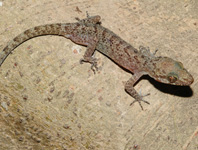Abstract
Two new species of Hemimycale from Southeastern Brazil are described in this study with the use of morphological and molecular data. Hemimycale oxeata sp. nov. is orange salmon colored in life and has unique oxeote like tornote spicules in addition to the typical (subtylo-)strongyles of the genus. Hemimycale ceadensis sp. nov. is reddish orange in life and has raised, tiny pore sieves, and subtylostrongyles with asymmetrical ends and raphides as microscleres. The diagnosis of the genus Hemimycale was slightly modified for the inclusion of the new species. Maximum-Likelihood analyses of 18S rRNA and COI sequences resulted in the clustering of both new species with the type species of the genus, thus confirming our morphological identification. The value of anatomical characters of pore sieves for diagnosing species and the genus is discussed. A key for species identification is also furnished.
References
Boury-Esnault, N. (1972) Une structure inhalante remarquable des spongiaires: Le criblé étude morphologique et cytologique. Archives de Zoologie expérimentale & générale, 113 (1), 7‒23.
Bowerbank, J.S. (1874) A Monograph of the British Spongiadae. Vol. 3. Ray Society, London, xvii + 367 pp., pls. I–XCII.
Burton, M. (1934) Sponges. Scientific Reports of the Great Barrier Reef Expedition 1928‒29, 4 (14), 513‒621, pls. 1‒2.
Hajdu, E., Berlinck, R.G.S. & Freitas, J.C. (1999) Porifera. In: Migotto, A.E. & Tiago, C.G. (Eds.), Biodiversidade do Estado de São Paulo: Síntese do Conhecimento ao Final do Século XX. Vol. 3. Invertebrados Marinhos, Fapesp, São Paulo, pp. 20–30.
Hajdu, E., Peixinho, S. & Fernandes, J.C.C. (2011) Esponjas Marinhas da Bahia. Série Livros 45. Museu Nacional/UFRJ, Rio de Janeiro, 276 pp.
Hentschel, E. (1929) Die Kiesel- und Hornschwämme des Nördlichen Eismeers. In: Römer, F., Schaudinn, F., Brauer, A. & Arndt, W. (Eds.), Fauna Arctica. Eine Zusammenstellung der arktischen Tierformen mit besonderer Berücksichtigung des Spitzbergen-Gebietes auf Grund der Ergebnisse der Deutschen Expedition in das Nördliche Eismeer im Jahre 1898. 5 (4). G. Fischer, Jena, pp. 857‒1042, pls. XII‒XIV.
Ilan, M., Gugel, J. & van Soest, R.W.M. (2004) Taxonomy, reproduction and ecology of new and known Red Sea sponges. Sarsia, 89, 388‒410.
https://doi.org/10.1080/00364820410002659Katoh, K. & Standley, D.M. (2013) MAFFT multiple sequence alignment software version 7: improvements in performance and usability. Molecular Biology and Evolution, 30 (4), 772–780.
https://doi.org/10.1093/molbev/mst010Kumar, S., Stecher, G. & Tamura, K. (2016) MEGA7: MEGA7: Molecular Evolutionary Genetics Analysis Version 7.0 for Bigger Datasets. Molecular Biology and Evolution, 33 (7), 1870‒1874.
https://doi.org/10.1093/molbev/msw054Moraes, F.C. (2011) Esponjas das Ilhas Oceânicas Brasileiras. Série Livros 44. Museu Nacional/UFRJ, Rio de Janeiro, 252 pp.
Morrow, C., Picton, B., Erpenbeck, D., Boury-Esnault, N., Maggs, C. & Allcock, A. (2012) Congruence between nuclear and mitochondrial genes in Demospongiae: A new hypothesis for relationships within the G4 clade (Porifera: Demospongiae). Molecular Phylogenetics and Evolution, 62 (1), 174‒190.
https://doi.org/10.1016/j.ympev.2011.09.016Muricy, G., Hajdu, E., Custodio, M., Klautau, M., Russo, C. & Peixinho, S. (1991) Sponge Distribution at Arraial do Cabo, SE Brazil. In: Magoon, O.T., Converse, H., Tippie, V., Tobin, L.T. & Clark, D. (Eds.), Coastal Zone ’91. Proceedings of the VII Symposium on Coastal and Ocean Management. (2). ASCE Publications, Long Beach, pp. 1183–1196.
Muricy, G., Lopes, D.A., Hajdu, E, Carvalho, M.S., Moraes, F.C., Klautau, M., Menegola, C. & Pinheiro, U. (2011) Catalogue of Brazilian Porifera. Museu Nacional, Série Livros, Rio de Janeiro, 300 pp.
Pulitzer-Finali, G. (1977) Report on a Collection of Sponges from the Bay of Naples. III Hadromerida, Axinellida, Poecilosclerida, Halichondria, Haplosclerida. Bollettino dei Musei e degli Istituti Biologici della (R.) Università di Genova, 45, 7–89.
Redmond, N.E., Soest, R.W.M. van, Kelly, M., Raleigh, J., Travers, S.A.A. & McCormack, G.P. (2007) Reassessment of the classification of the Order Haplosclerida (Class Demospongiae, Phylum Porifera) using 18S rRNA gene sequence data. Molecular Phylogenetics and Evolution, 43 (1), 344–352.
https://doi.org/10.1016/j.ympev.2006.10.021Rützler, K. (1978) Sponges in coral reefs. In: Stoddart, D.R. & Johannes, R.E. (Eds.), Coral reefs: research methods. Unesco, Paris, pp. 299–313.
Spalding, M.D., Fox, H.E., Allen, G.R., Davidson, N., Ferdaña, Z.A., Finlayson, M., Halpern, B.S., Jorge, M.A., Lombana, A., Lourie, S.A., Martin, K.D., Mcmanus, E., Molnar, J., Recchia, C.A. & Robertson, J. (2007) Marine Ecoregions of the World: A Bioregionalization of Coastal and Shelf Areas. BioScience, 57 (7), 573‒583.
https://doi.org/10.1641/B570707Topsent, E. (1928) Spongiaires de l’Atlantique et de la Méditerranée provenant des croisières du Prince Albert ler de Monaco. Résultats des campagnes scientifiques accomplies par le Prince Albert I, 74, 1–376, pls. I–XI.
Uriz, M.J., Garate, L. & Agell, G. (2017) Molecular phylogenies confirm the presence of two cryptic Hemimycale species in the Mediterranean and reveal the polyphyly of the genera Crella and Hemimycale (Demospongiae: Poecilosclerida). PeerJ, 5, e2958.
https://doi.org/10.7717/peerj.3490Vacelet, J., Donadey, C. & Froget, C. (1987) The calcium carbonate spherules of Hemimycale columella (Demosponges, Poecilosclerida) and their taxonomic value. In: Vacelet, J. & Boury-Esnault, N. (Eds.), Taxonomy of Porifera from the NE Atlantic and Mediterranean Sea, NATO ASI Series G13, pp. 259‒274.
https://doi.org/10.1007/978-3-642-70892-3_13Van Soest, R.W.M. (2002a) Family Hymedesmiidae. In: Hooper, J.N.A. & van Soest, R.W.M. (Eds.), Systema Porifera, a guide to the classification of sponges. Kluwer Academic/Plenum Publishers, New York, pp. 575‒593.
Van Soest, R.W.M. (2002b) Family Crambeidae Lévi, 1963. In: Hooper, J.N.A. & van Soest, R.W.M. (Eds.), Systema Porifera: A guide to the classification of sponges. Kluwer Academic/Plenum Publishers, New York, pp. 547–555.
Van Soest, R.W.M., Boury-Esnault, N., Hooper, J.N.A., Rützler, K., de Voogd, N.J., Alvarez de Glasby, B., Hajdu, E., Pisera, A.B., Manconi, R., Schoenberg, C., Janussen, D., Tabachnick, K.R., Klautau, M., Picton, B., Kelly, M. & Vacelet, J. (2011) World Porifera Database. Available from: http://www.marinespecies.org/porifera (accessed 29 August 2017)

